Archives
-

Mirroring political transformations: Book publishing in the Post-Soviet and Post-Yugoslav spaces
Vol. 10 (2024)This thematic issue edited by Bella Delacroix Ostromooukhova, Anne Madelain and Daria Petushkova examines the transformations of the book publishing ecosystem following the end of socialist regimes in Eastern Europe. By comparing the post-Soviet and post-Yugoslav spaces, it uncovers a plethora of material that can be used to analyze the major changes in the publishing industry in the context of globalization. This dossier also argues that the focus on publishing and its actors represents an innovative approach to the study of political change in contemporary societies, whether in terms of forms of social control, national identity or the modalities of internationalisation.
The special issue opens with an article by Daria Petushkova, which traces the trajectory of ‘Progress Publishers’ in the years of perestroika and examines the process of emancipation of the Soviet publishing system from state control in the early 1990s’. Vanda Mikšić and Mirna Sindičić Sabljo focus on the modalities of the circulation of the French-language literature translated into Croatian since 1991, while Anne Madelain analyses the circulation of books between the successor states of Yugoslavia, which raises the question of the highly political definition of linguistic and cultural borders. Bella Delacroix Ostromooukhova describes the emergence of a circle of critical children’s book publishers in Russia since the 2000s, interested in Western translations, and examines how the war in Ukraine has changed their practices and activities. This event, which turned the Russian book industry upside down, is also the focus of the study she co-authored with Dmitrii Khriakov. In their article, the authors decipher the development of the ‛Black Centurion’ publishing house and the associated Foliage bookstores, as well as their involvement in the Russian aggression against Ukraine. The issue concludes with an article by Aglaé Achechova, published in the ‘Open Fora’ section. This article deals with the phenomenon of the “new tamizdat”, a new chain of production of Russian-language books, free from censorship, outside the Russian borders, which began to develop after the beginning of the war in Ukraine.
As a special feature, the ‘Open Fora’ section contains an interview conducted by Ciryl Prost with the historian Adjarbek Kočkunov, a former citizen of the Soviet Union living in the Kyrgyz Republic. Through the personal journey of this scholar, this exchange offers an insight into the post-Soviet transformations of Kyrgyzstan.
Finally, four book reviews conclude this 10th Volume of Connexe.
-
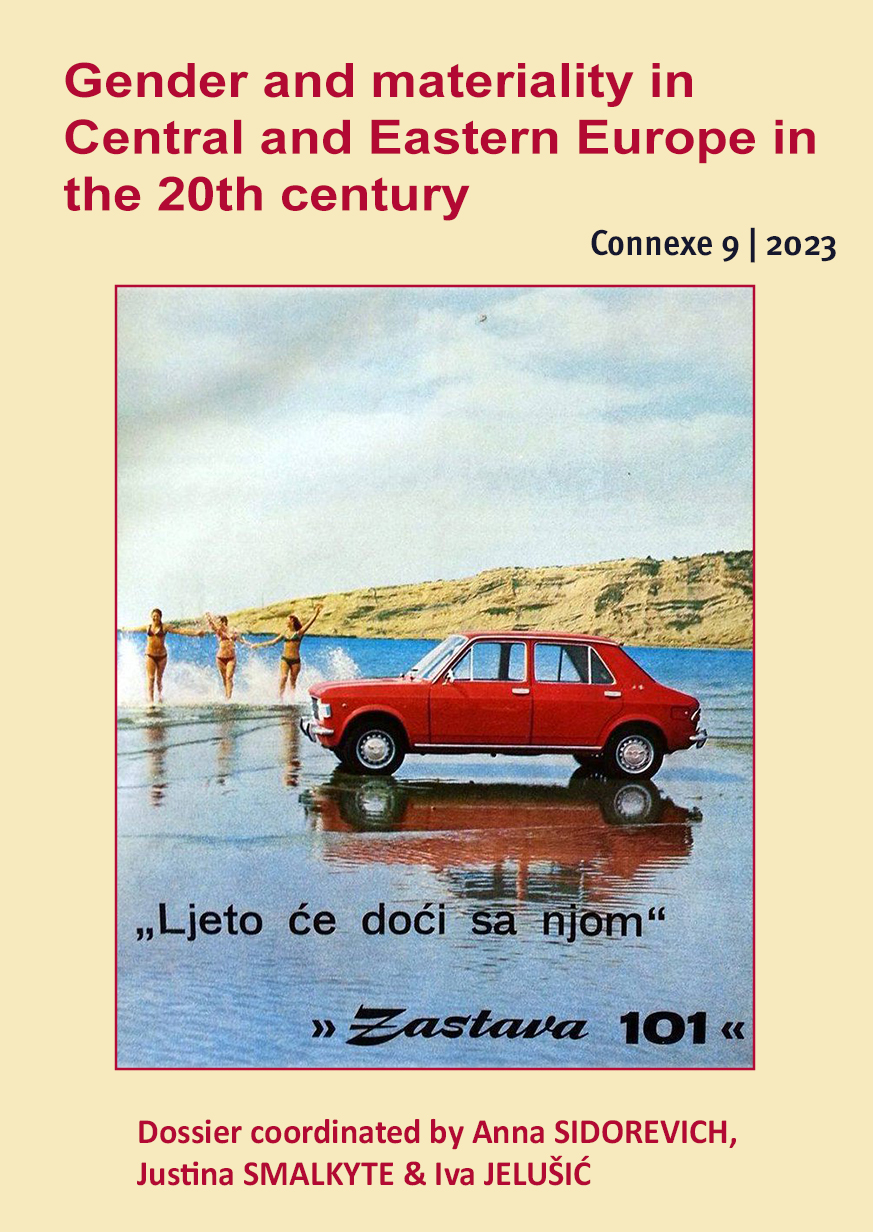
Gender and materiality in Central and Eastern Europe in the XX century
Vol. 9 (2023)The aim of this special issue, entitled “Gender and Materiality in Central and Eastern Europe in the XX century”, edited by Iva Jelušić, Justina Smalkyte and Anna Sidorevich, is to contribute to gender research in the Central and Eastern European context from the perspective of material culture studies. Although not all of the contributions use objects as their “primary data”, they all explore the complex interplay between materiality and gender.
This dossier opens with an article written by Ivana Mihaela Žimbrek and Lea Horvat that traces the evolution of Yugoslav kitchen design from the early 1950s to the early 1970s. Anna Sidorevich analyzes the mistreatment of women during childbirth and abortion in the late Soviet Union. Julia Mead delves into a dedicated Czech hobbyist community who are preserving a collection of socialist-era domestic appliances. Marta Chmielewska explores Poland’s transition from socialism to capitalism by examining shifts in the production and advertising of underwear. Martyna Miernecka investigates the interplay between socialist institutions promoting creative work and the history of typewriters in Central and Eastern Europe.
The dossier is enriched by an article by Kristen Ghodsee, published in the “Open Fora” section, entitled “Revenge of the Tampon: Gender and Materialisms (New and Old) in 20th Century Central and Eastern Europe”.
Finally, the “Stop on Archives” section contains two texts: An interview with researchers involved in the research project “Cartography of Resistance”. This project examines the underground networks established to resist the fascist Ustasha [Ustaša] authorities during the Second World War on the territory of the Yugoslav countries (1941-1945), which had their roots in the leftist labor movement of the interwar period and the activism of the Communist Party of Yugoslavia. In the second text, Iva Jelušić shares some of her findings on songbooks and the importance of singing for members of the partisan anti-fascist resistance on the territory of Yugoslavia during the Second World War.
By looking at different kinds of objects, the authors make new contributions to the history of everyday life and gender relations under state socialism and communism.
This volume has been enriched by a text outside the main issue. In the “Open Fora” section, Éric Aunoble gives us his observations on the preservation of sources in Ukraine which include the results of a field survey (« Les sources de l’historien·ne au péril de la guerre »).
Finally, four book reviews conclude this Volume 9 of Connexe.
-
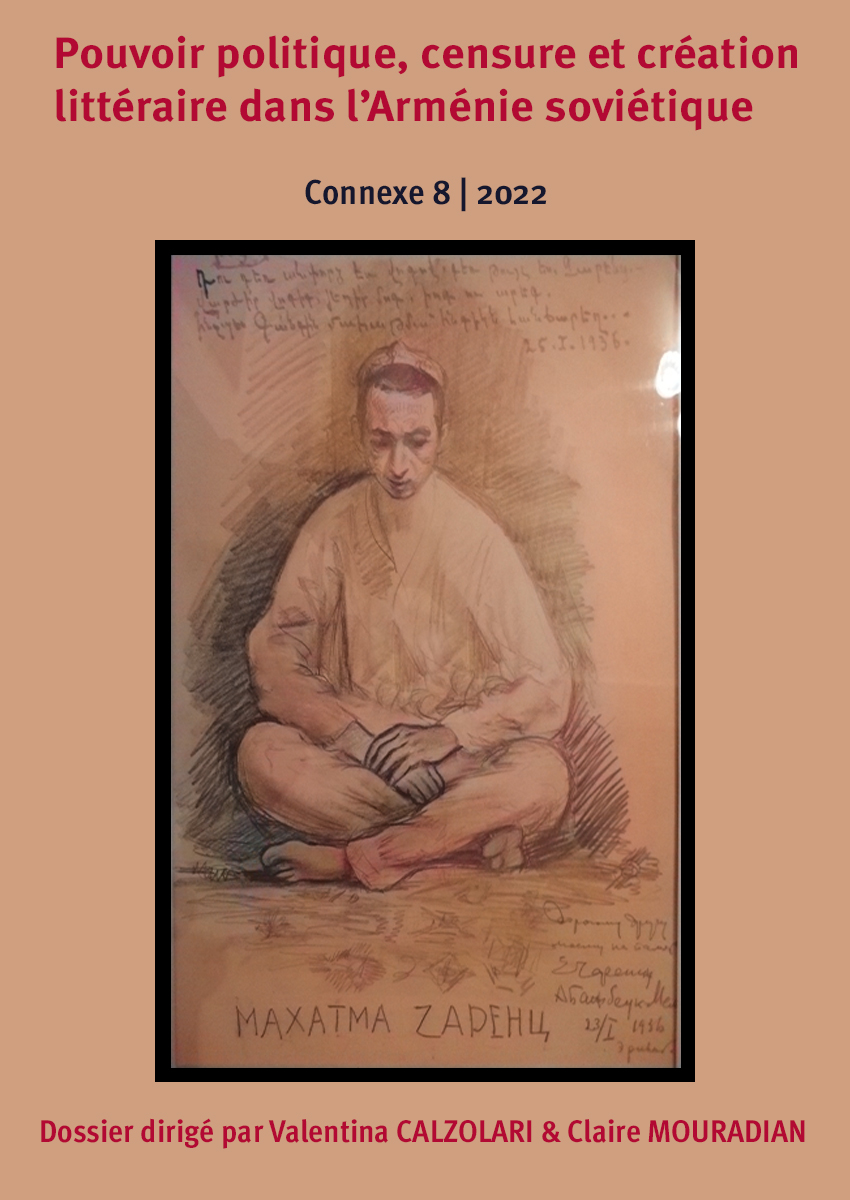
Political power, censorship and literary creation in Soviet Armenia
Vol. 8 (2022)This Special issue, co-directed by Valentina Calzolari and Claire Mouradian, opens with an introductory article by Claire Mouradian, which focuses on Soviet-Armenian literature and studies the relationship between the Communist power and the writers, following the various phases of the history of the USSR. Elisabeth Mouradian Venturini’s article deals with Yeghishe Ch’arents’, a poet inspired by the internationalist revolution, and studies this writer’s attachment to the Armenian national theme. Valentina Calzolari analyses Gurgen Mahari’s Barbed Wires on Blossom and recalls the censorship that targeted, for different reasons, this work of testimony on the Gulag, as well as the novel Burning Orchards, by the same author. Vartan Matiossian’s article focuses on the relationship between Soviet Armenia and the Diaspora through the life and work of Kostan Zarian, and shows the project of nation building through literature dear to this writer. Finally, Cécile Vaissié analyses the travelogues of Vasily Grossman and Simone de Beauvoir, and studies their complementary views on Armenia, its society, and its literary world in the 1960s.
The “Open Fora” section offers, in an annotated translation by Haïk Der Haroutiounian, an essay by poet Violet Krikorian (Grigorian), who analyses the literary bridge between Vahan Terian and Yeghishe Ch‘arents’. At the time of the second independence in 1991, she retrospectively questions the relationship between literature and politics, as well as the role of the intelligentsia vis-à-vis the Sovietisation.
In the section “Stop on Archives”, the article by David Gasparian, in Claire Mouradian’s annotated translation, gives a concrete example of censorship in the dark years by commenting on one of the lists of works censored during the Great Terror.
Without exhausting the subject, this dossier offers a diversity of approaches that may help shed light on a period and a literature that are still little known and little studied.
This volume has been enriched by several texts outside the main issue:
- in the “Varia” section, Radzhana Buyantueva’s article analyses the role of foreign and international (Western) NGOs in Russian LGBT activism;
- in the “Open Fora” section, Mikhaïl Minakov analyses a century of Ukrainian political system; Vincent Exiga and Marina Fedorovsky convey in their article the voices of five Armenian feminists involved in various forms of activism. Finally, the article by Tania, an independent Russian artist, gives us in the form of a diary her observations on the changes that have affected Moscow and Russia since February 2022, and she asks herself these obsessive and inescapable questions: how could this happen? Could something have been done to avoid the catastrophe?
Finally, five book reviews conclude this Volume 8 of Connexe.
-

Russian Civil War after 1917: multi-level approaches to a conflict and its representation
Vol. 7 (2021)One hundred years after the end of the Civil War in the former Russian Empire, we wanted to study these “naked" years, “[of] death, [of] lies, [of] anguish, [of] horror”, in the words of Boris Pilniak. To introduce the dossier, we draw on the work of Dominique Kalifa to show how a “semantic [and] memorial layer” was formed from the events of 1917–1921. The contribution of Hanna Perekhoda, from the University of Lausanne, addresses the reconfiguration of identity and new sovereignties through the emergence of the Soviet Republic of Krivoi Rog in 1918. Denis Denisov, from the EHESS, raises the question of social conflicts during the Civil War by studying the workers of the Sevastopol shipyards. The loyalty of former military officers to their convictions or their rallying to the new regime is the subject of the work of Kirill Nazarenko, from the State University of Saint Petersburg. He follows the fate of the fleet officers through the crisis. Elizaveta Zhdankova studies the reception of Soviet films on the Civil War by the spectators of the 1920s in the USSR. This dossier is completed by a study by Alexis Berelowitch on the peasants in the Civil War, combining archival documents and historiographical assessment. Alexandre Bourmeyster’s more personal text evokes the Ice March through his father’s story, who fought in the war. The dossier concludes with an analysis of an archival document on a French sailor who joined the Russian Bolsheviks during the Allied intervention. This last contribution has been done by Denis Denisov, who, at the intersection of “great history” and an individual destiny, retraces this journey.
-
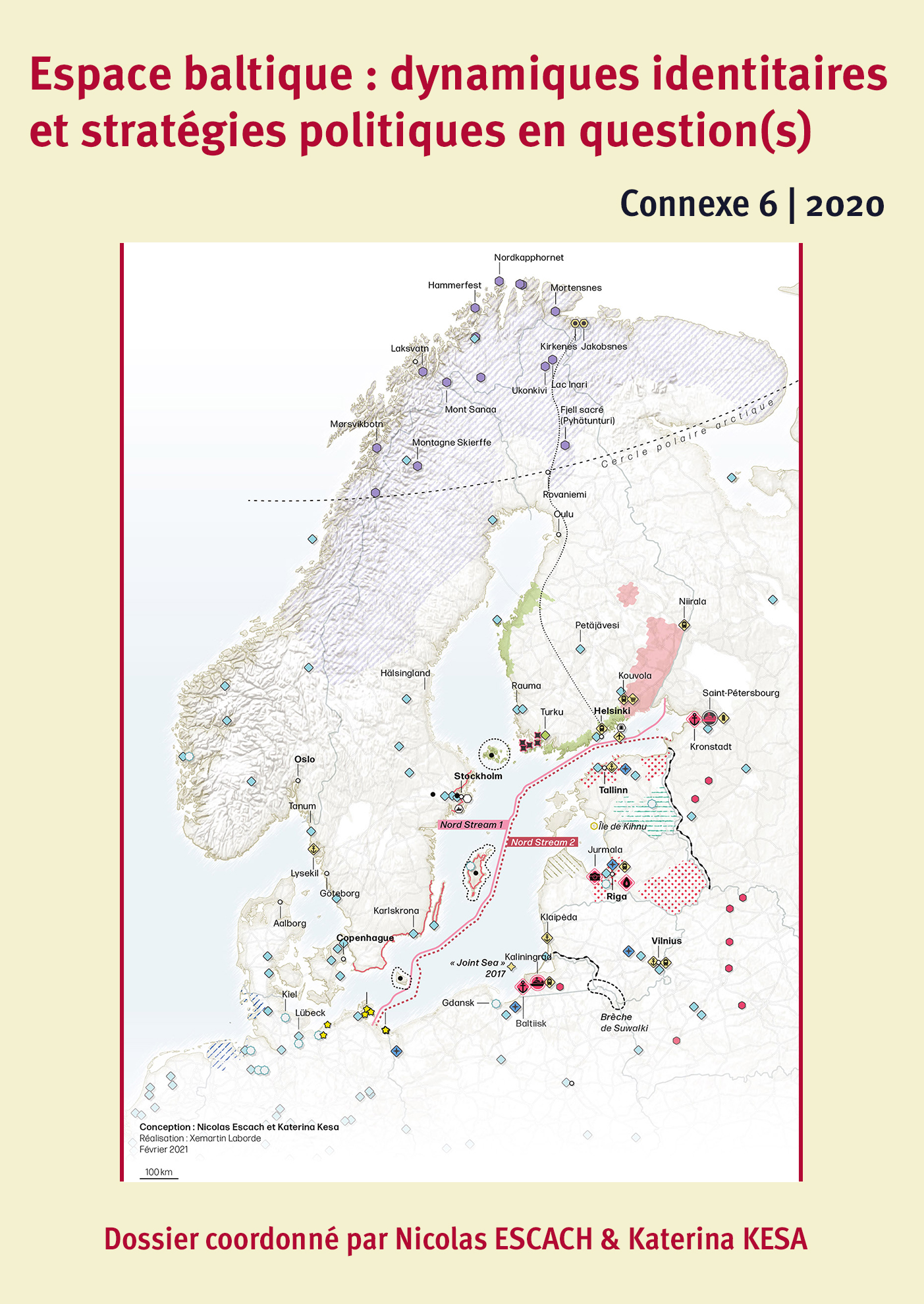
Espace baltique : dynamiques identitaires et stratégies politiques en question(s)
Vol. 6 (2020)Ce dossier, co-dirigé par Nicolas Escach et Katerina Kesa, interroge les dynamiques identitaires et les stratégies politiques des acteurs de l’espace baltique depuis les années 1980 jusqu’à aujourd’hui. L’introduction propose de définir l’espace baltique et ses problématiques. L’article de Kaarel Piirimäe se penche sur les choix des élites estoniennes en termes de « politique existentielle » durant la perestroïka jusqu’au début des années 1990 ; celui de Emilija Punziute-Gallois analyse le comportement des diplomates baltes sur la scène internationale, marqué, selon l’auteure, par une logique sécuritaire, l’importance de l’ordre international et des valeurs libérales et démocratiques. Lauriane Létocart établit une relation entre l’identité et le tourisme dans le Land de Mecklembourg-Poméranie-Occidentale, où le tourisme est un facteur d’intégration identitaire, le cadre baltique générant des pratiques touristiques singulières. Nicolas Escach poursuit une réflexion autour de l’identité en insistant sur le rôle, le statut et les caractéristiques de la mer Baltique. Avec un focus particulier sur Kaliningrad comme lieu de croisement d’histoires, d’espaces et d’identités multiples, Colin Horenbeek interroge l’impact de la matérialisation des différentes époques sur le processus de construction identitaire que connaissent cette ville et ses habitants. Les deux derniers articles mettent l’accent sur des ruptures en cours des dynamiques identitaires dans la région nordico-baltique : Sophie Enos-Attali analyse l’évolution de la politique de sécurité en Finlande et en Suède et Katerina Kesa se penche sur la tendance aux replis identitaires par la montée des mouvements populistes d’extrême droite dans les sociétés nordiques et baltiques. Le dossier se clôture avec une interview croisée avec deux chercheurs, Marko Lehti et Heiko Pääbo sur ce qui pourrait composer cette région aujourd’hui en comparaison avec les années 1980 et 1990.
-
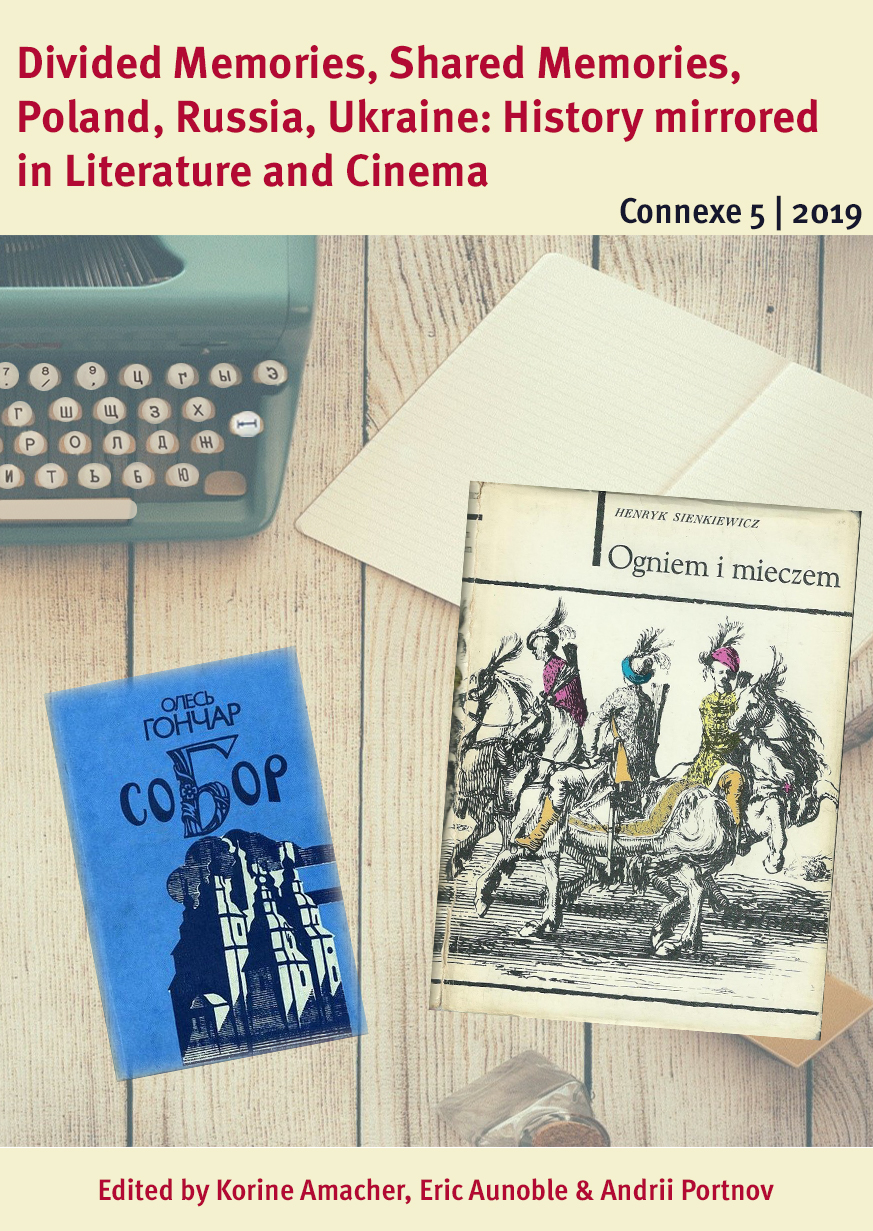
Divided Memories, Shared Memories, Poland, Russia, Ukraine: History Mirrored in Literature and Cinema
Vol. 5 (2019)Modern attitudes to sources have radically changed during the last decades. Nowadays the use of literary texts and movies is an accepted practice in historical research. Although a novel or a movie does not itself faithfully recount Ranke’s “wie es eigentlich gewesen” (how things really were), its history is part and parcel of not only cultural but also political and social history. Films and literature are also part of the writing of history in another sense. During a century when mass culture reached the people, films and novels brought a vision of the past and helped build the common memory of nations in Central and Eastern Europe.
The aim of the dossier entitled Divided Memories, Shared Memories, Poland, Russia, Ukraine: History mirrored in Literature and Cinema, edited by Korine Amacher, Eric Aunoble, and Andrii Portnov, is to examine the artistic treatment of certain events and figures described in contradictory narratives in 20th-century Poland, Russia, and Ukraine. The articles examine: (1) Mikhail Bulgakov’s novel The White Guard (1926) set in Kiev during the Civil War; (2) The role of Mykola Khvyl’ovyy (1893–1933), a major writer in 1920s’ Soviet Ukraine, a leader in the struggle for a Soviet Ukrainian literature independent of Russian models; (3) The public interactions between figures as different as Mykola Khvyl’ovyy and the national literary critic Dmytro Dontsov (1883–1973), supporter of “integral nationalism,” despite the physical and ideological borders between Soviet Ukraine and inter-war Poland; (4) Henry Sienkewicz’s novel With Fire and Sword (1882–1888) about the 17th-century Cossack revolts that left their mark on the history and collective imaginations of Poles, Ukrainians, and Jews; (5) The Volhynian Massacre in Soviet Partisans’ Memoirs; (6) The cooperation between Poles and Soviets to produce films about the two major figures of communism, Lenin and Feliks Dzerzhinskiy. This dossier is also supported in the “Open Fora” section by an article on Kazimir Malevich (1879–1935), the father of radical abstract painting.
In the new section “Stop on Archives” of this journal, Volume 5 of Connexe is also enriched by two contributions dealing with: (1) The trajectory of Stalinist Executioners from the Revolution to the Great Terror, and (2) The Life and Fate of Leonid Nikolaev.
-
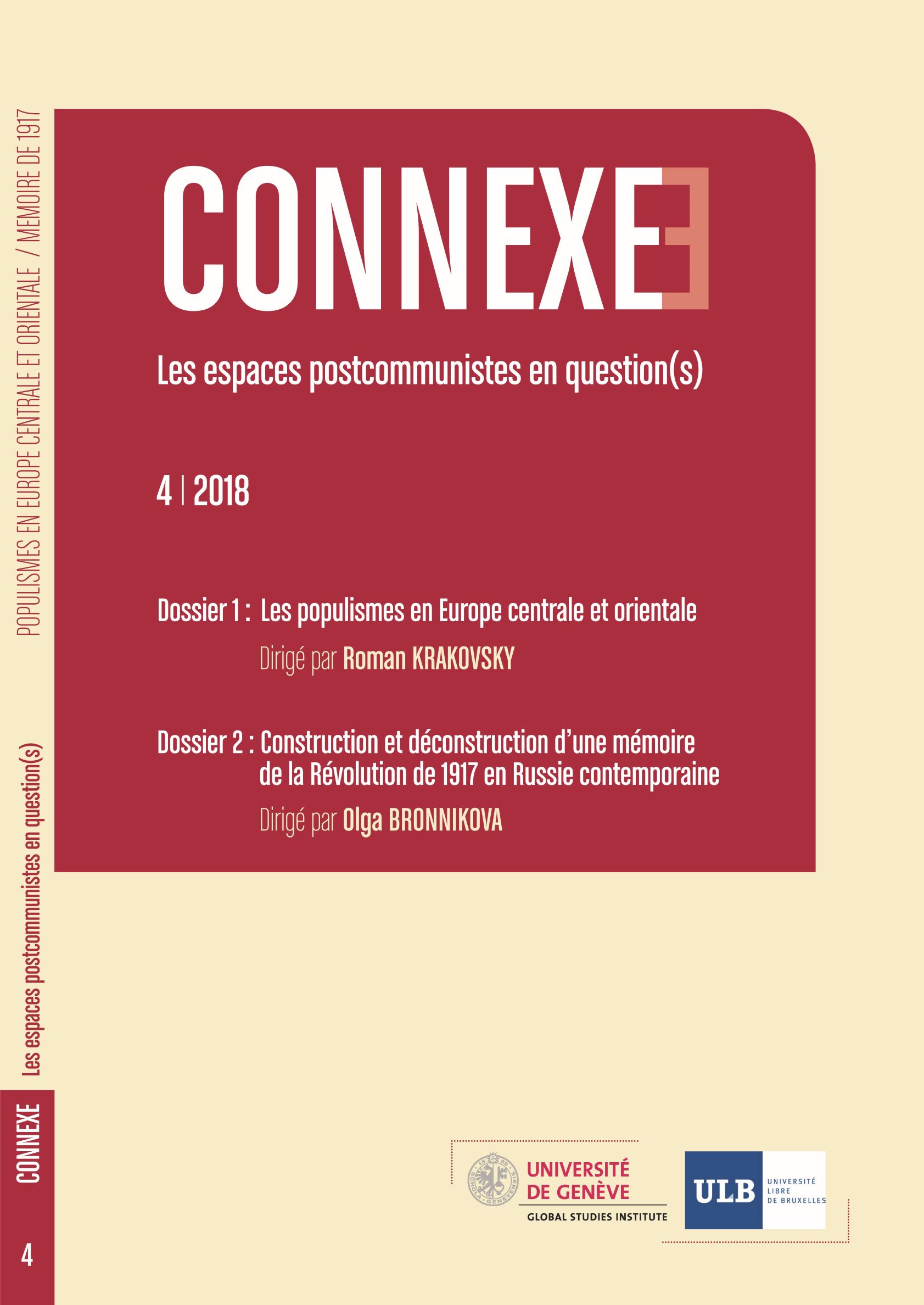
Les populismes en Europe centrale et orientale; Construction et déconstruction d'une mémoire de la Révolution de 1917 en Russie contemporaine
Vol. 4 (2018)Ce volume comprend 2 dossiers thématiques et un article varia.
Le premier dossier, dirigé par Roman Krakovsky, étudie les outils de mobilisation des masses qui permettent de mieux comprendre les succès des populismes en Europe centrale et orientale. Les contributions analysent la manière dont les mouvements populistes recourent aux idéologies et doctrines politiques qui opéraient dans cette partie de l’Europe et qui définissaient le peuple successivement selon l’appartenance à une ethnie (États-nations), une race (régimes d'extrême-droit profascistes) ou une classe (régimes communistes). Les auteur·e·s ayant contribué à ce dossier sont : Wim van Meurs pour l'Europe centrale, Estelle Bunout pour la Pologne, Máté Zombory pour la Hongrie et Traian Sandu pour la Roumanie.Le second dossier, dirigé par Olga Bronnikova, tente d’analyser plus en détails les discours officiels et alternatifs russes des années 1990-2010 sur les révolutions de 1917 afin de faire apparaître les tensions et les contradictions qui s’y trouvent et d’éclairer l’évolution des politiques de l’histoire depuis la chute de l’URSS. Olga Belova, Valéry Kossov et Olga Konkka soulignent dans leurs articles respectifs le silence des autorités russes sur la révolution de Février, laquelle continue implicitement d’être appréhendée comme un simple prélude à la « véritable » révolution d’Octobre. L’article de Konstantin Morozov inaugure une nouvelle rubrique intitulée « Champ libre ». L'auteur, historien et membre de l’ONG russe "Memorial" nous livre un témoignage qui remet en question non seulement le récit des autorités sur 1917 mais aussi celui des libéraux russes, dans la mesure où ils tendent à ramener l’ensemble des courants révolutionnaires de gauche aux bolcheviks.
Nikos Papadatos nous propose, en article varia, une analyse sur l’Union soviétique et la guerre civile grecque entre 1944 et 1949.
-

War Spoliations and Cultural Transfers: The Case Study of Soviet Cinema (1939-1949)
Vol. 3 (2017)This special issue of Connexe dedicated to “War Spoliations and Cultural Transfers: The Case Study of Soviet Cinema (1939-1949)”, directed by Éric Aunoble, aims to set the history of Soviet cinema during the Second World War in the context of European history and to highlight the issues of transfers and seizures which are better known when concerning other objects, as archives or works of art. This collection of articles is one of the last achievements of the scientific project called Cinema in the Soviet Union at war, 1939-1949.
Sophie Coeuré presents a state of the art based on the historiographical advances related to the films that were looted during World War Two and put it in the context of a broader history of cultural goods during war and post-war periods. Christina Tanis presents with some remarkable archival documents how the 1942 German documentary about the Nazi expedition to Tibet became a Soviet film in 1948 denouncing local theocracy and British imperialism. Juliette Denis & Irina Tcherneva trace the tribulations of “Red Mist”, an anti-Soviet documentary film released in Latvia under Nazi rule on the other side of the Cold War front. Éric Aunoble studies the changing representations of Poland in Soviet movies during the war, linked with the peregrinations and career development of movie makers. Jeremy Hicks tells us how British officials tried to propagandise a positive image of their new eastern ally without giving ground to communist agitprop.
In contributing to the development of the historiography of war spoliation, we hope to shed light on some unknown aspects of cultural exchanges in Europe during the Second World War and to confirm the value of cinema for historical knowledge.
-

Sotchi 2014 : La Russie à l'épreuve de ses jeux, les jeux à l'épreuve du Caucase
Vol. 2 (2016)Ce numéro spécial, dirigé par Ekaterina Gloriozova et Aude Merlin, interroge les enjeux politiques des JO de Sotchi. A l’heure où les explications macrosociologiques prévalent dans l’analyse des grands événements sportifs, il se centre sur les dimensions internes et locales. Issu d’un colloque international organisé à l’ULB en février 2014, le dossier inclut des travaux de chercheurs occidentaux, russes et caucasiens privilégiant des approches qualitatives et des études intensives de cas, et donne notamment une visibilité aux travaux de jeunes chercheurs.
L’article de Jean Radvanyi expose les difficultés liées aux enjeux que constitue la tenue des JO pour le pouvoir russe. Veronika Pasynkova explore les discours présents au sein des nouveaux médias et les compare aux perceptions de l’opinion publique russe. Nikolay Karbainov & Ekaterina Gloriozova mettent en lumière les problèmes de corruption qui entravent le bon déroulement du processus d’expropriation des propriétés en vue de la préparation des Jeux. Vera Galindabaeva expose les mesures d’éradication des chiens errants des villes russes avant les grands événements sportifs s’apparentant à un nettoyage de façade, se faisant au prix du non-respect des droits des animaux. Giulia Prelz Oltramonti démontre que les forces de sécurité russes ont peu à peu raison des velléités indépendantistes abkhazes après la reconnaissance de l’indépendance de l’Abkhazie par la Russie. L’article d’Ahmet Yarlykapov vise quant à lui à comprendre comment se recompose l’identité circassienne, dans un contexte où les questions mémorielles sont réactivées de façon exacerbée au fur et à mesure qu’approchent les Jeux. Enfin, Irina Babitch montre la complexité des modalités de régulation sociale et les enchevêtrements ou mises en concurrence des différents types de normes, selon la nature des litiges et par-delà les changements de régime depuis le XIXe siècle. Ce dossier présente donc une diversité d’approches qui, nous l’espérons, pourra contribuer à combler certains manques dans la littérature sur les Jeux de Sotchi.
-

L'URSS et la Russie contemporaine face à l'humanitaire
Vol. 1 (2015)La préparation de ce numéro spécial, dirigé par Catherine Goussef et Amandine Regamey, a coïncidé de façon très inattendue avec une actualité controversée, à savoir l’acheminement d’une aide humanitaire russe aux régions d’Ukraine orientale en proie, depuis le printemps 2014, à un affrontement entre forces séparatistes dites « pro-russes » et armée ukrainienne régulière. Ce numéro est en grande partie issu d’une manifestation scientifique intitulée « Protection de la population en temps de guerre et action humanitaire en URSS », organisée à Moscou en mars 2013. Fondée en 1867, la Croix-Rouge russe apparaît à la veille de la Grande Guerre comme l’une des plus anciennes et des plus puissantes organisations ayant joué un rôle important dans la dynamique du mouvement (cf. Conférence Internationale des Croix-Rouge à Saint-Pétersbourg, 1892).
L'introduction au dossier, intitulée "Russie-URSS-Russie, un siècle d’humanitaire", brosse un panorama historique de l'aide humanitaire dans cette région du monde. L'article de Yulia Khmelevskaya porte sur l’aide de l’American Relief Association (ARA) qui se distingua par l’importance de l’aide apportée, mais également par son mode d’intervention ; celui de Jean-François Fayet sur l’histoire des acteurs engagés dans la lutte contre la famine dans la jeune Russie soviétique. Catherine Goussef revient dans son article sur les différents pans de cette assistance, soulignant le caractère inédit de la latitude d’action obtenue par les Polonais sur le territoire soviétique. Agnès Blais analyse l'ouverture du territoire de l'URSS aux organisations internationales, et la naissance de nouvelles organisations de solidarité soviétiques impulsées par la vague des réveils populaires et citoyens de la perestroïka, comme l’association « Assistance civique ». Viennent ensuite les contributions de Laurence Binet sur les tensions au sein de Médecins Sans Frontières (MSF) sur la question des positionnements publics de l’organisation, et celle d'Eva Bertrand qui analyse la montée en puissance du MTchS (Ministère des situations d’urgence), organe qui centralise l’aide, dans un contexte d’émergence de la Russie comme acteur du jeu humanitaire.



